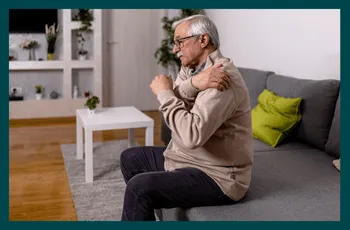Pain management - How to deal with chronic pain without medication?
Written by Dr Nelson Lau, MBBS FRACGP, GP & Digital Health Specialist

Contents

A topic that doesn't get nearly enough attention – chronic pain. It's that persistent ache, sting, or throb that overstays its welcome, making everyday life feel like an uphill battle. Maybe it's in your back, head, joints, or somewhere else entirely. But one thing's for sure: it's not just "in your head."
Where does chronic pain occur?
Chronic pain isn't picky. It can strike anywhere in the body. Some common spots include:- Back: Think of lower back pain from an old injury or neck pain from too much screen time.
- Head: Tension headaches and migraines are frequent (and unwelcome) visitors.
- Joints: Conditions like arthritis or old sports injuries can cause chronic joint pain.
What causes chronic pain?
There are a number of reasons why chronic pain develops. Sometimes, it's the aftermath of an injury that never fully healed. Other times, it's tied to underlying conditions like fibromyalgia, endometriosis, or nerve damage. Even stress and mental health can play a role.How do you deal with pain without medication?
The good news is that you have more options than you might think. While medication can be helpful, it's not the only answer. There are a multitude of natural, effective ways to manage pain and reclaim your life.At-home remedies for pain management
- Heat therapy: Heat helps relax muscles and increase blood flow, which can ease pain. Try warm baths, showers, or even a hot water bottle.
- Cold therapy: For some types of pain, like inflammation or acute injuries, cold can be your best friend. Use ice packs, frozen veggies, or a cool compress.
- Gentle movement: Exercise might be the last thing on your mind, but gentle movement like yoga, tai chi, or swimming can work wonders. They improve flexibility, strengthen muscles, and release endorphins (natural painkillers).
- Relaxation techniques: Stress can amplify the chronic pain. You can find pain relief through meditation, deep breathing, or progressive muscle relaxation. Even just a few minutes a day can make a difference.
- Sleep: Think of sleep as your body's reset button. Aim for 7-8 hours of quality sleep each night. A good sleep routine can help you wake up feeling refreshed and better able to cope with pain.
- Diet: What you eat matters. A balanced diet rich in anti-inflammatory foods like fruits, vegetables, whole grains, and healthy fats can help reduce inflammation and ease pain.
- Mindfulness: This is all about being present in the moment. By focusing on your breath and sensations, you can train your brain to respond to pain differently.
- Supplements: Certain supplements like turmeric, omega-3 fatty acids, and magnesium may help with pain. But always talk to your doctor before starting any new supplements.
Therapy options to explore: Your path to pain relief
Physical therapy:
Think of physical therapists as your personal trainers for pain management. They'll assess your specific needs and create a customised exercise plan to improve strength, flexibility, and range of motion. This can help reduce pain, improve function, and prevent further injury. They might also use techniques like manual therapy (hands-on techniques to mobilise joints and soft tissues) and modalities like ultrasound or electrical stimulation.Occupational therapy:
Occupational therapists are the masters of adapting. They'll work with you to find ways to perform everyday activities—like getting dressed, cooking, or working—with less pain and more efficiency. They might suggest assistive devices, teach you energy conservation techniques, or help you modify your environment to make it more pain-friendly.Cognitive Behavioural Therapy (CBT):
Chronic pain isn't just physical; it can also take a toll on your mental health. CBT helps you break the cycle of negative thoughts and behaviours that can worsen pain. You'll learn coping skills, relaxation techniques, and strategies to manage stress and improve your overall well-being.Acupuncture:
This ancient practice involves inserting thin needles into specific points on the body. While it might sound intimidating, most people find it painless. Acupuncture is thought to stimulate the release of endorphins (natural painkillers) and reduce inflammation. Some studies suggest it can be effective for chronic pain conditions like back pain, osteoarthritis, and headaches.Massage Therapy:
A good massage isn't just a luxury; it's a legitimate form of pain relief. It can loosen tight muscles, improve blood flow, and reduce stress hormones. Different types of massage, like Swedish massage, deep tissue massage, or myofascial release, may be beneficial for different types of pain.Biofeedback:
This high-tech therapy involves using sensors to monitor bodily functions like heart rate, muscle tension, and skin temperature. You'll learn to control these functions through relaxation techniques and visual or auditory feedback. This can help reduce pain, stress, and improve overall well-being.Transcutaneous Electrical Nerve Stimulation (TENS):
This portable device sends mild electrical currents to the skin, which can help block pain signals and stimulate the release of endorphins. TENS units are often used for conditions like arthritis, back pain, and nerve pain.Virtual Reality (VR):
VR isn't just for gaming; it's also a powerful tool for pain management. By immersing you in a virtual world, VR can distract you from pain, reduce anxiety, and promote relaxation. It's been used to help people cope with acute pain, chronic pain, and even phantom limb pain.Is there a cure for chronic pain?
For many people, chronic pain is an ongoing condition. But that doesn't mean you can't live a full and active life. The goal is to find the right combination of treatments that work for you.When to call the doctor?
If your pain is severe, impacting your daily life, or not getting better with at-home remedies, don't hesitate to talk to your doctor. They can help you create a personalised pain management plan.Can telehealth help?
Absolutely! Telehealth consultations are a convenient way to connect with a doctor or therapist from the comfort of your own home. It's a great option if you have limited mobility or difficulty accessing in-person care.You're not alone
Living with chronic pain is tough, but you don't have to do it alone. Reach out to friends, family, or support groups for encouragement and understanding. Remember, you have the power to take control of your pain and live the life you want. Remember, finding the right therapy or combination of therapies is a personal journey. Don't hesitate to explore different options and talk to your healthcare providers to find what works best for you.Feeling sick and unsure why? Speak with a GP online in 15 minutes.
See a Doctor now
Available 24/7, across Australia.
Feeling sick and unsure why? Speak with a GP online in 15 minutes.
See a Doctor now
Available 24/7, across Australia.
What we treat
- Cough
- Nausea & vomiting
- Fever
- Hayfever
- Fatigue
- Sore throat
- Acne
- Hair loss
- Gout
- Eczema
- Rosacea
- Sunburn
- UTI
- Erectile dysfunction
- Contraception
- Morning sickness
- Morning after pill
- Prostate health
- Anxiety
- Depression
- Stress
- Grief & loss
- Antidepressants
- Premature ejaculation
- Asthma
- Blood pressure
- Blood thinners
- Diabetes
- Cholesterol
- Migraines & headaches
- Allergies
- Body ache
- Heartburn & reflux
- Sleep disorder
- Pain relief
- Gastro
Related Articles
Disclaimer
This blog is for general informational purposes only and does not indicate that Hola Health provides all treatments or preventive measures mentioned. It is not intended to be a substitute for professional medical advice. Always seek the guidance of your doctor or other qualified health professional with any questions you may have regarding your health or a medical condition. For emergencies please immediately contact 000. Any medical topics discussed are intended to educate, not to imply availability through Hola Health.
 Facebook
Facebook  X
X  Copy Link
Copy Link



